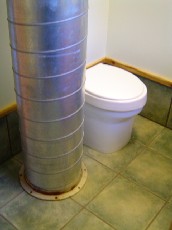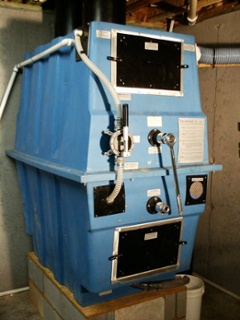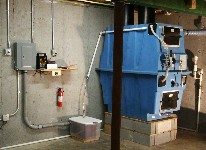Won’t That Stink? — Living in a Green Home with a Composting Toilet

Ten years ago I was building a green home. It had passive solar features, was built out of structural insulated panels, sent all the greywater out to the back yard to water fruit trees, and was going to be super energy efficient. One feature above all others, though, captured people’s attention when I described the house to them — the composting toilet. The first reaction of many of them was:
“Ooh. Won’t that stink?”
Why bathrooms with composting toilets smell better
We installed the kind of composting toilet with a large tank in the basement. The tank had a small fan that constantly exhausted air from the tank through the vent on the roof. So, whenever anyone went to the bathroom and…uh…did their business, the bathroom smelled better than before they went in there. The reason is that as soon as they opened the lid on the toilet, air from the bathroom was being pulled down through the toilet, into the basement tank, and then sent out through through the roof.
A lot of people are down on negativity (Say NO to negativity!), but actually it’s a good thing when channeled properly. Negative pressure  inside a composting toilet means you never have to worry about walking into a bathroom that’s had all the oxygen sucked out of the air (as I heard it described once).
inside a composting toilet means you never have to worry about walking into a bathroom that’s had all the oxygen sucked out of the air (as I heard it described once).
OK, composting toilets are about a lot more than bathrooms that don’t stink. The main reason that people who consider themselves environmentalists install them is to prevent problems associated with waste treatment plants and septic tanks. In this age of ‘going local,’ they keep the organic matter at home (unlike a sewer system) without polluting the ground water (unlike many septic tanks).
But let’s skip over all the big picture, environmental stuff. If you’re considering a composting toilet, you want practical information, so here’s my advice to you, based on the three years I spent living in one…uh, I mean living in a house with one.
Practical advice on composting toilets
Don’t get a small one. You know, the kind that’s an all-in-one unit that just sits on the floor in any bathroom. It has a small tray at the bottom that you slide out to remove the waste. I had some friends in Florida who had one, and they hated it. You have to empty it far too frequently, and it doesn’t really get enough mass to get the composting going. And unlike the one I had, they’re smelly.
Use compost starter. When you read the instructions for composting toilets, they tell you that you have to put some starter microbes in the tank to make the composting happen. They give you two choices: Buy their special starter or throw a shovelful of soil in the tank. We chose the latter and had a plague of little fungus gnats living in the tank. (I could write a whole article just about my battle with those annoying little critters.) I suspect that using the soil from outside was the source of our gnat problem.
Consider a foam-flush or micro-flush toilet. Some people are squeamish about doing what comes natural into a tank where they can see that other people have also been doing what comes natural. Crazy, I know, but it’s true. These types of toilets also give you the flexibility to install the toilet in locations other than directly above the tank.
In case you’re wondering, we went with the Phoenix composting toilet by Advanced Composting Systems in Whitefish, Montana. The owner had previously worked for Clivus Multrum, the big name in composting toilets. I was pleased with the design, sturdiness, and functionality of the  toilet. It was also fairly easy to assemble and install (for someone who’s handy with tools and used to doing this kind of stuff, that is). I recommend checking out both of those brands.
toilet. It was also fairly easy to assemble and install (for someone who’s handy with tools and used to doing this kind of stuff, that is). I recommend checking out both of those brands.
If you’re in the Atlanta area, you can check out the Clivus Multrum with a foam flush toilet at Southface Energy Institute’s Eco Office near downtown.
Because the tank was so large and there were only two of us living in the house (for the first three years anyway), we didn’t have to empty the tank until it had been in use for four years. At that point, I wasn’t living in the house anymore but went back to help with the first removal of the compost in 2007.
It was nice stuff! The Phoenix has two access doors, an upper one and a lower one, as well as two large axles that run the length of the tank, each with several tines. When you open the lower door, you can pull out all the old stuff from the bottom and the axles and tines keep the newer stuff from falling. Cool!
each with several tines. When you open the lower door, you can pull out all the old stuff from the bottom and the axles and tines keep the newer stuff from falling. Cool!
Finally, for those of you who think these modern composting toilets are too fancy or expensive, I recommend The Humanure Handbook. I don’t think you’ll ever get their design approved by a building department, but it’s definitely low-tech and cheap. All you need is a 5 gallon bucket, a toilet seat, and some sawdust.
Allison Bailes of Atlanta, Georgia, is a speaker, writer, building science consultant, and the founder of Energy Vanguard. He has a PhD in physics and writes the Energy Vanguard Blog. He is also writing a book on building science. You can follow him on Twitter at @EnergyVanguard.
Related Articles
Comments are closed.
This Post Has 9 Comments
Comments are closed.

Another great post, Allison.
Another great post, Allison. I had been “negative” on composting toilets after seeing (smelling?) a bad installation. But never really considered that it was the installation, not the technology.
Allison,
Allison,
Great topic, water use and waste disposal are issues that we need to get a better handle on.
In the New England area folks might want to check out this building http://www.forestsociety.org/ourproperties/ac-conservation-center.asp. I had the privilege of working on the construction project and it is truly a marvelous building. It also has a gray water system that uses a plant bed to treat the water and improve IAQ.
There are two composting systems, a Phoenix with the direct drop fixtures and a Clivus with foam flush toilets on the 2nd floor.
The building went into service in 2001 and the issues with the systems have been minor at worst.
They love to have people tour the building, check with the property manager if you want a in depth tour.
what about composting toilets
what about composting toilets in tight homes w/ hrv? i’ve heard of a few projects where people route the exhaust fan from the composter through hrv, but that seems a little risky to me.
What a fun way to end this
What a fun way to end this informative article which I’m passing along to a friend who is planning to install one
Good feedback from someone
Good feedback from someone who has actually lived with it. I shared with my wonderful wife and it was not positive.
One should seriously consider resale value before installing one of these. Especially, in this type of market.
Hi Allison: Nice concept, but
Hi Allison: Nice concept, but what does one usually do with all that “old stuff” when it comes time to finally remove it?
The humanure concept comes not without some controversy. While in the old days, folks often relied on “privy soil” as a form of gardening manure, it’s often advised against today. The reason why highly decomposed cow manure (for example) is beneficial for gardening is because it contains much vegetable matter. But human and domestic pet manure is usually going to contain a lot of animal fat, something not recommended for composting, generally.
Anyway, I certainly agree with the concept of composting waste, rather than sending it down the sewer line or into a septic system. But it’s not clear to me what one otherwise does to regularly dispose of the composted waste, other than bury it, burn it, or pack it up with the trash.
I think it’s time we consider
I think it’s time we consider a composting toilet too, great post you have here!
my husband and I are working
my husband and I are working towards building a energy efficient home with solar panels and such…that said we re curious as to how much energy your phoenix compost toilet system used
Kris: The
Kris: The Phoenix had only a 5 watt fan, which uses a pretty small amount of energy. We ran it off of a couple of golf cart batteries on a trickle charger. That way, the fan would always run even if the power went off.